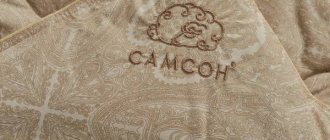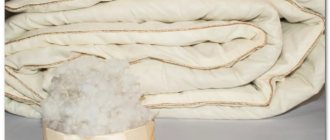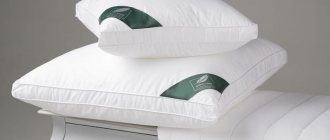Wool products always attract the eye, but require proper care, otherwise their appearance will quickly deteriorate. Often clothes lose their properties due to improper cleaning. How to wash woolen items to maximize their service life? How to maintain softness, color, and reduce the appearance of pilling? Read this article and you can always avoid mistakes in caring for woolen clothes.
Basic recommendations
There are general rules on how to wash wool without harming it.
- We do not recommend wetting knitted items too often. Even an accidentally placed stain, do not rush to clean it immediately; it is better to dry it and try to remove it with a brush.
- Pull the item that has shrunk after washing in different directions to return it to its original size.
- Wet stretched clothing items and dry them near a heat source, such as a heater.
- Sometimes replace washing with dry cleaning. Wash knitted and woolen items no more than once every six months.
- Natural fabric easily absorbs odors. For this reason, it is not recommended to dry wool products in the kitchen.
- If soaking is required, it should last no longer than 15 minutes.
Brush any fluffy material before washing.
Firstly, you will remove some of the dirt, and secondly, pellets will not appear on the product for longer. Before starting the “water procedures,” turn things inside out and sort them by color. Wool fabric fibers can stick to other things, you will have to clean them with a brush. For the same reason, do not put woolen and other items into the drum at the same time.
Use warm water for washing and rinsing. Neither cold nor hot will do.
Rinse, dry and other recommendations
Wool items should be rinsed well in plenty of water. Otherwise, the detergent residue will eat away at the fibers, causing holes to appear. Do not forget that the temperature of the water for rinsing should be the same as for washing, otherwise the product will shrink.
How to wash a wool sweater to make it shrink? Sometimes this is necessary, for example, when the clothing size is too big or it has stretched. Here you can break the above rules and wash the wool in hot water.
The material should be dried flat on a horizontal surface. Since wool actively absorbs moisture, it becomes significantly heavier after washing. If you hang it, the fibers will stretch. When drying, clothing should not be exposed to direct sunlight. Avoid sources of heat and hot air, and be sure to ventilate the room.
Please note: substances such as vinegar, peroxide, and bleaches are not applied to wool in their pure form. Before use, be sure to dissolve them in water, and only then put your clothes in it.
What to do if the item shrinks after washing? There is no need to wash it again immediately. The following measures will help:
- lightly sprinkle the item with water and iron it, stretching it slightly;
- iron through damp gauze;
- process with a steamer, giving the desired shape.
How to wash woolen items by hand
Washing wool items by hand is considered safe if done correctly.
- Fill the container with warm water (up to 30 degrees).
- Pour or pour in the product intended for wool and delicate fabrics, following the proportions recommended in the instructions, mix.
- Immerse the soiled knitted item and rub in the areas where the stains are concentrated. You can soak the item for 15 minutes.
- Without twisting, rinse the clothes two to three times until clean.
- Shake and dry the clean product.
Preparation process
Before you wash sheep's wool at home, you need to clean out the debris. Then the products are divided into white, multi-colored and dark. They also select very dirty items with stains. If there are very dirty areas, clean them using a clothes brush or special means. If there are holes, the clothes need to be sewn up so that they do not tear further. When washing for the first time, it is better to do a shedding test.
Machine washable
Washing wool products in a machine is acceptable if the program is correctly selected. Then things will not shrink in size or stretch. Some devices are equipped with special modes. For knitted products, “delicate fabrics”, “hand wash”, “wool” are suitable. If your machine does not have these, select the following settings:
- temperature less than 30 degrees;
- no spin;
- minimum speed;
- additional rinse.
When choosing a detergent, the same recommendations apply as for hand washing: it should be liquid, intended for delicate and woolen materials. It’s also a good idea to add conditioner to a special compartment or drum to keep things fluffy and smelling nice.
Features of wool when washing
Wool is a natural raw material. In general, it is divided into living and dead. The first is sheared from live sheep, the material is characterized by increased softness, wear and durability. Wool, called dead wool, has much worse characteristics because it is obtained from slaughtered animals in slaughterhouses. Before looking for the answer to the question of how to properly wash woolen products, you need to find out what type of material will be processed. Today the following varieties are known:
- camel's wool;
- merino (a special breed of fine-wool sheep that is shorn only at the withers);
- cashmere (down from Tibetan goats);
- mohair (fur from Angora goats);
- Angora (fluff obtained from very fluffy Angora rabbits);
- alpaca (a type of wool obtained from Peruvian llamas).
The labels will help you figure out at what temperature to wash wool. The fact is that natural wool is a very fancy material. In particular, when washing it can:
- deform;
- change color;
- sit down;
- lose natural softness.
Decoding symbols for caring for natural wool products.
Often, washing wool, or more precisely, white items, ends with them turning yellow. In addition, pilling often occurs on washed woolen clothes.
Washing dark and light items
The question of how to wash wool of dark colors deserves special attention. Experienced housewives recommend the method using mustard.
- Dilute mustard powder with water.
- Strain the mixture, add water and leave to infuse.
- Wash the product in the resulting solution, without using detergents, and then rinse thoroughly.
Pay close attention to light wool. Before washing, soak yellowed white items in water with previously added hydrogen peroxide.
Folk remedies
Mustard powder is used to wash dark clothes. 1 glass of dry matter is dissolved in a small amount of water, filtered and allowed to brew, then added to a basin and washed. An alternative to industrial air conditioners is ammonia. 1 teaspoon of the substance will soften the fabric.
Washing white wool items is a separate issue. When machine washing, bleach may be added. Hydrogen peroxide refreshes yellowed clothes: 1 tablespoon of peroxide per 1 liter of water. Soak the clothes briefly in this solution, then wash and rinse well.
Another effective folk method is crushed chalk. You will need 1 kg per 3 liters of water. Soak the yellowed wool item in the solution, then wash it. The canvas will bleach.
How to properly wash woolen items if they fade
To test the color fastness of a sweater or scarf, dip part of the item in water, wring it out and iron it through a napkin. If marks remain on the paper, the fabric is washed separately from other items, adding vinegar to the water, which will allow the dye to fix on the fibers.
How to dry woolen items correctly
The fibers of wet woolen fabric are easily damaged, so strictly follow the algorithm described below.
- Gently wring out the item without twisting it.
- Wrap in a terry towel or clean soft cloth and allow excess water to be absorbed.
- Lay out on a dry, dense cloth, smooth out the folds with your hands.
- Turn items that are too dense every 12 hours during the drying process.
Attention! Do not dry knitted items of clothing in the sun, near heating appliances, or use hangers, hair dryers, or irons.
How to prepare items for washing
In order for wardrobe items to be washed well and not deformed, they should be prepared in advance:
- If among the contaminated items there are items made of angora or mohair, set them aside: they require only hand washing.
- Sort items into dark and light ones; they should be washed separately from each other.
- If the item will be washed for the first time, you need to find out whether it is fading. To do this, wet the edge of the product and iron it on a white fabric. If you see a mark of color, such clothing should be washed separately from other items.
How to iron woolen items
Wrinkles in wool clothing are a rare occurrence and occur when they are not dried or stored improperly. If a knitted item is wrinkled, do not rush to iron it, because ironing can lead to irreversible consequences.
It is better to iron such clothes under a press or by steaming them over hot water. If you have no time to wait, turn on the iron, but follow the following rules:
- let things dry completely;
- turn inside out;
- use the steam function;
- place an iron (clean thin fabric) between the sole of the device and the product;
- do not press too hard with the iron;
- move the sole only where there are folds;
- Do not use the maximum temperature.
Rules for drying wool clothes
It is necessary to dry the wool on a straight surface, turning it over occasionally. If you hang the product on a rope, it may stretch. It is better to dry on the table. Do not leave things where food is being prepared. They will quickly absorb foreign odors. When the threads contain artificial elements in addition to wool, they are squeezed out a little, carefully straightened and hung to dry on hangers.
If the room is cool and the products take a long time to dry, you can use a hairdryer. The switched-on device must not be kept close. It is not advisable to place the product on a hot battery.
Wool thread becomes brittle when exposed to temperatures above 60 degrees Celsius and low levels of moisture. These conditions also tend to cause yellow spots to appear.
Certain items can be ironed by turning them inside out beforehand. It is better to do this through gauze or thin cotton cloth soaked in a mixture of a glass of water and half a tablespoon of table vinegar. This way you can avoid the appearance of shine on the material. Ironing helps to slightly remove shrunken clothes. To do this, you just need to moisten it a little. The iron is set to position 2 or “wool”, it all depends on the model of the electrical appliance.
When ironing, do not press hard on the iron so as not to particularly deform the clothes. An exception to the rule is when the material needs to be specially stretched.
How to get shrunken clothes back into shape
During washing, clothes may shrink. In this case, you can try to stretch it. Because of this, it is important to know at what temperature things shrink, so as not to spoil the product. There are several options for restoring shrunken clothing.
1 way. Turn the clothes inside out and moisten with a spray bottle. Then stretch it to the sides with your hands and dry it.
Method 2. Gives better results. Warm temperature water (not higher than 30 degrees) is poured into the container. Excessively cold water can change the shape much more. Add a little conditioner, which is intended for rinsing. After 10 minutes, remove the product and remove the water with a terry towel. Place it horizontally on a flat surface, straightening it out. When the item dries, every 20 minutes you need to slightly stretch the material in a wide variety of directions. You can also put the clothes on yourself if it is not too uncomfortable. To prevent it from shrinking, stretch the hat comfortably and dry it in a three-liter jar.
3 way. Is the most cardinal. Use if the first two types do not help. However, there is a risk of damaging the product. Sequence of actions:
- make a soap-based solution;
- add 3 tbsp. lie ammonia and 1 tbsp. lie turpentine;
- soak for 24 hours;
- stretch carefully.
It is better to perform these actions with things that contain only wool. Because after a long stay in the mixture, the structure of the fibers is damaged and the warming qualities deteriorate.
Before stretching the item, you should also read the care instructions on the tag. If individual parts have come together (sleeves, collar), not the entire product can be wetted.
It would be a good idea to store washed clothes on a shelf in your closet. It is best to carry out treatment against moths, which can break the material. Bulky things are placed below and light things on top. It is necessary to sometimes remove and air the wool. This prevents creases from occurring.
Now knowing how to properly wash wool items, you can ensure proper care at home.
Storage
Things knitted from wool are capricious, therefore:
- You cannot hang clothes on hangers, otherwise the fabric will be deformed and stretched;
- the same product should not be worn for several days in a row;
- remove pellets that appear on woolen fabric with a special machine;
- do not store clothes folded on top of knitted items in the closet;
- purchase an anti-moth product and put it in places where woolen products are stored.
By using simple instructions for caring and washing woolen items, you will ensure that your clothes will last longer with their softness, warmth and attractive appearance.
Some tips
It is not enough to wash and dry wool properly. These products require more careful care:
- Do not hang woolen items on hangers - they will stretch and become ugly. Place wool in piles: bulky and heavy items down, lighter items up.
- Store items in closets along with moth repellents. For example, sachets with aromatic herbs or bars of soap repel pests.
- If the product can be ironed, use the “wool” mode.
- Several times a year, woolen clothes should be taken out into the sun, aired and shaken. This will help avoid dampness and unpleasant odors.
That's all you need to know about washing and caring for wool. Take care of your woolen products and attract admiring glances.
Ironing at home
Such items should be ironed with caution, as they can easily be damaged by high temperatures. To avoid this, you need not to exceed the temperature threshold, and, if possible, do without ironing at all. As with washing, before ironing you need to familiarize yourself with the symbols on the label, if there is one .
Ironing of products is indicated by special icons:
- Crossed out with iron . This means that the product must not be steamed or ironed.
- Iron with one point inside . Ironing is allowed without steam, through gauze, at temperatures below 100 degrees.
- Iron with two points inside . Ironing and steaming through damp gauze is allowed at temperatures up to 150 degrees.
- Iron without additional symbols . Ironing is permitted without temperature restrictions.
Important! Only purified water is poured into the tank of the steaming iron. This will protect against dirty stains on the soleplate of the iron and on the fabric.
If there is no label on the clothing, but ironing is necessary, you can use the general rules:
- do not heat the iron to a temperature exceeding 150 degrees;
- iron the item only through gauze;
- use an ironing board, covering its surface with a thick, light-colored cloth;
- use a device with a steamer, thermostat and non-stick soleplate;
- Do not iron things with relief and voluminous patterns throughout the entire product.
Do not iron wet woolen items - this can deform them. You need to let them dry completely.
Steaming
This gentle procedure is suitable for hand knitted wool products. Sweaters or other clothes are steamed in a horizontal position. To maintain shape, hats are placed on a glass jar.
It is better to steam wool with a steam generator, but an iron with a steamer will also work:
- to avoid stretching of clothes, they are straightened out on hangers and secured with pins in the desired position;
- the item is covered with gauze;
- pour purified water into the tank, heat the iron and treat the product with steam without touching the surface;
- periodically moisten the gauze, preventing it from drying out;
- After the procedure, the items are allowed to completely cool and dry.
Useful tips for Pavloposad shawls and other products
And you can do without ironing:
- After washing, mohair clothes should be wrapped in a towel, gently wrung out and laid out to dry on a horizontal surface.
- Creases on an openwork product are removed using a wooden rolling pin. The item is placed between two damp towels, laid horizontally and rolled repeatedly with a rolling pin. Products with long pile and down scarves are also smoothed.
- If you don’t have an iron and a steam generator, a hair dryer will also help out. The wool is covered with damp gauze and treated with hot air from a hairdryer, holding the device at a small (1 cm) distance from the surface.
- High temperatures are contraindicated for white wool products. To prevent it from turning yellow and losing its attractive appearance, it is ironed and steamed at a minimum temperature.
What to do if a woolen product is stretched
The opposite situation also happens - when you take out an item from the drum that is 1-2 sizes larger than the original one. In this case, you need to soak it in water at a temperature of 40 - 50 degrees for 10 minutes, and then dry it in a horizontal position.
If only a separate part of the product is stretched, for example, the sleeves, then only them need to be soaked.
Features of sweaters, blankets and other products made from camel, sheep and other wool
Wool is a natural organic material that is obtained from the hair of various animals.
Finished wool products can be produced:
- from goat hair - mohair, cashmere;
- llama, alpaca, vicuna wool;
- camel hair;
- different types of sheep - merino, first-shorn lamb wool, etc.
Each type of fabric has its own characteristics. They are determined by the type of production of a particular type, the presence of synthetic additives, the manufacturing method, and the cut of the finished product.
Working with specific wardrobe items
Regardless of what subject we are talking about, extreme care will be required.
Sweaters and jackets
If soaking is necessary, do it briefly. The wool sweater should only be washed by hand using a mild detergent. No rubbing, twisting or squeezing. Place a clean jumper on a towel and roll it up. Then lay it out on a horizontal surface.
Hats
In the off-season and winter, a wool knitted hat is a real lifesaver. But the natural composition requires proper care. If you neglect the recommendations and wash knitted items incorrectly, the hat will shrink and lose its former attractiveness.
The knitting of the hat can be tight or loose. The last option cannot be machine washed. You can still try the first one. It is better to simply clean products of a certain shape and then put them on an inverted jar. With shapeless options, it’s easier to do so; no scrupulous or particularly careful attitude is required.
Angora and cashmere hats should only be washed by hand. The same applies to a fur version or a product with a pompom. You can risk loading other types of yarn into the machine. The hat must be in a special case. For washing, gel, shampoo or grated soap is suitable, preferably baby soap.
Socks
Wool socks should be washed, again using delicate products and warm water. When washing colored socks, add table vinegar to the water. The movements are crumpling. Wash and rinse at 30 degrees Celsius. To wring it out, you need to roll the sock and apply a little pressure. Dry on a flat surface.










